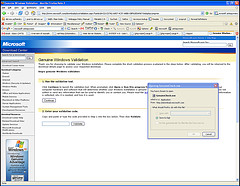
flickr.com/hendry
If your computer is behaving oddly, is slowing down, gets hung up in the middle of your work, or is bedeviled with “pop-ups,” then it is possibly infected with spyware.
Spyware gets into your computer due to something you have done, like installing free games, clicking a button on a pop-up window, or programs or software.
It is appraised that anywhere from twenty to fifty percent of online network traffic is accomplished by spyware.
In fact, on eighty percent of all business systems networks incorporate ad-ware; fifteen percent of these networks have system monitoring software running in the background.
There are lots of applications for the removal of spyware and for spyware detection like, Ad-aware, Spybot, and Microsoft Anti-Spyware. These provide vigorous detect+J9ion and safeguard from spy-ware as well as internet cookie identification (which then lets you know where the cookies came from).
A good anti-spyware program must have the following:
1. Definition updates. This tool lets the user download updates to their anti-spyware in order to further protect their computer as new spyware is created.
2. Real-time monitoring. This is similar to the anti-virus “real-time scanner.” That means the anti-spyware software runs continuously in the background – even when you’re busy working on other projects on your computer. When a malicious program is discovered trying to install spyware on your computer, the real-time monitoring is always ready to react to it. This is a feature normally available only on paid versions of anti-spyware.
3. “Restore browser settings.” While you have to be updated at digging around in the advanced settings or advanced tool menu of your computer in order to find it, most anti-spyware have an option that can re-set the setting of their web-browser if you’ve been the victim of “browser hijacking.” You must, however, be able to immediately restore the browser to its previous home page, or to reestablish the factory defaults.
4. Safe removal and rollback. An anti-spyware shouldn’t just delete spyware, it should be able to do so in a safe manner. It would be useless to delete spyware and find an empty blue-screen the next time you turn on your computer. All spyware should be able to be taken out without damage to your computer. However, some anti-spyware, may be too vigilant. Your program should not leave you without a way to restore your computer to its original condition. This might mean the spyware will still be there, but at least you won’t lose your important documents.
Many programs don’t find it necessary to be that aggressive. There are lots of programs out there that do a good work. Such programs test the contents of the “operating system file” in the Windows registry. Then they eliminate documents and entries that correspond to their list of identified spyware.
Always make it a point to install anti-spyware programs before you go browsing through the internet. They offer so many advantages that help you fight against and defend yourself from frustrating and annoying spyware.
Tagged with: anti-virus • spyware protection
Filed under: Device Drivers